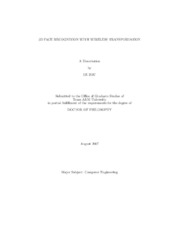| dc.description.abstract | In this dissertation, we focus on two related parts of a 3D face recognition system with wireless transportation. In the first part, the core components of the system, namely, the feature extraction and classification component, are introduced. In the feature extraction component, range images are taken as inputs and processed in order to extract features. The classification component uses the extracted features as inputs and makes classification decisions based on trained classifiers. In the second part, we consider the wireless transportation problem of range images, which are captured by scattered sensor nodes from target objects and are forwarded to the core components (i.e., feature extraction and classification components) of the face recognition system. Contrary to the conventional definition of being a transducer, a sensor node can be a person, a vehicle, etc. The wireless transportation component not only brings flexibility to the system but also makes the “proactive” face recognition possible.
For the feature extraction component, we first introduce the 3D Morphable Model. Then a 3D feature extraction algorithm based on the 3D Morphable Model is presented. The algorithm is insensitive to facial expression. Experimental results show that it can accurately extract features. Following that, we discuss the generic face warping algorithm that can quickly extract features with high accuracy. The proposed algorithm is robust to holes, facial expressions and hair. Furthermore, our experimental results show that the generated features can highly differentiate facial images.
For the classification component, a classifier based on Mahalanobis distance is introduced. Based on the classifier, recognition performances of the extracted features are given. The classification results demonstrate the advantage of the features from the generic face warping algorithm.
For the wireless transportation of the captured images, we consider the location-based wireless sensor networks (WSN). In order to achieve efficient routing perfor¬mance, a set of distributed stateless routing protocols (PAGER) are proposed for wireless sensor networks. The loop-free and delivery-guaranty properties of the static version (PAGER-S) are proved. Then the performance of PAGER protocols are compared with other well-known routing schemes using network simulator 2 (NS2). Simulation results demonstrate the advantages of PAGER. | en |


